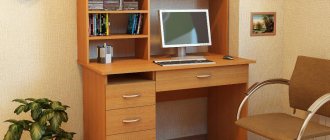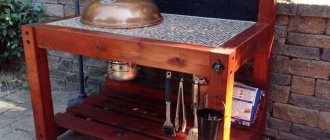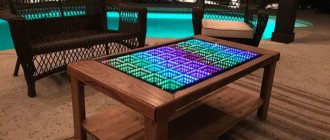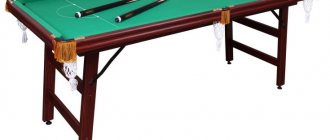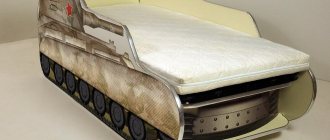Materials
When assembling a cutting table from chipboard with your own hands, you should maintain an optimal balance between functionality, safety, time and money. This can be achieved by selecting parts and materials with the necessary parameters. It is possible to reduce costs by using old parts of other structures - furniture, frames of wooden houses and outbuildings.
Tabletop
The main requirements for a saw table are resistance to heavy loads, shocks and vibration. The tabletop must be smooth enough to move and not bend under a weight of 50 kg or more. Suitable options might be:
- Metal (steel or duralumin) 3–5 mm thick. The advantages of metal countertops are high strength, almost unlimited service life, the disadvantages are heavy weight, decent cost.
- Laminated chipboard or moisture-resistant plywood with a thickness of at least 2 cm. The cost of this option will be the most profitable, but the strength is noticeably reduced.
- Textolite 15–20 mm thick. The material is more durable than plywood, but inferior to metal. In terms of cost, textolite countertops are also between metal and plywood sheets.
Plastic, chipboard or OSB are not recommended as countertop materials. A structure made from this raw material will be unstable to vibration from the saw. It is possible to make a table entirely from natural wood, but it is too expensive.
Metal
laminated chipboard
Textolite
bed
At the base of the table for sawing boards there can be wooden beams, secured under the lid to increase rigidity. Elements with a cross-section of at least 5 x 5 cm are placed at a distance of 50–90 mm from the edge of the tabletop. For the sawing table, it is recommended to choose bars made of hard wood - beech, hornbeam, oak. The advantages of wood are low cost, easy installation using self-tapping screws. Disadvantages - less strength and service life, high probability of fire.
The upper part of the table frame for cutting chipboard and other materials is often made by hand from the same sheets that were chosen for the table top. For the legs of a wooden structure, it is recommended to use timber, securing it with metal corners. The pros and cons of wooden supports are similar to the features of a frame made of the same material.
The basis of the table for cutting and sawing boards can be metal. Stability increases when choosing metal corners or channels with sides of 25–50 mm. To save money, they are purchased at scrap metal collection points or replaced with profile pipes. The frame parts are connected by welding. The use of bolted connections is not recommended due to the possibility of loosening due to vibration. The reasons for choosing a metal frame are maximum strength, reliability, and easy maintenance. Disadvantages: high cost, need to use a welding machine.
Metal
Wooden beams
Chipboard plywood
Finishing
After manufacturing and assembling the circulation table, to simplify working moments, it is advisable to apply markings .
It is this that will make it easier to cut materials. To extend the life of the product and increase its aesthetics, a hand-made table can be primed and varnished . These manipulations will also prevent the lumber from sliding on the surface and protect the product from increased moisture.
Features of a circular saw
Knowledge of these features is extremely important; you must take into account the operating modes of the saw, know the type of loads and take all possible measures to strengthen the most important components. Only with this approach can long-term and safe operation of a homemade machine be achieved.
What are the common features of woodworking machinery?
High speed saw teeth. This ensures the quality of sawing. But high speeds of the saw blade cause serious injuries; during the manufacture of the machine, great attention must be paid to safety precautions. All devices available on industrial copies must be installed without fail. Do not think that some of them are superfluous, and you will be able to modernize factory samples for the better. All safety rules are written in the blood of injured people, do not repeat tragic mistakes.
Strength of all nodes
This means the inability to withstand significant static loads, although this is very important. The table can easily absorb large forces of this type, but at the same time vibrate under the influence of even relatively minor dynamic multidirectional loads. This condition does not have a negative impact on safety, but noticeably deteriorates the quality of the cut.
Marks of teeth are noticeable on the surface of lumber, it is difficult to maintain specified linear dimensions, etc.
Fire and electrical safety. Absolutely all electrical devices, motors, starters and other special fittings must be installed in strict accordance with the requirements of the PUE. You need to know that dry sawdust not only burns well, but also forms an explosive mixture at a certain concentration in the air. By the way, burning sawdust is difficult to extinguish; it floats on the water and continues to burn.
There is no need to make the simplest machine at the expense of safety devices; strictly follow the recommendations of the designers. Decide what you need, a woodworking machine or fresh problems?
Additional Important Information
Carpentry work requires special attention. If you want to make a high-quality and highly reliable table for a circular saw with your own hands, then be well prepared for the work.
Do the following:
- Purchase all the necessary materials and equipment without exception.
- After installing the frame, be sure to install it on a flat plane and check that the cover of the structure does not overhang in any direction.
- It is better to install the table for the circular saw in the area where it will be located in the future in order to eliminate possible problems associated with uneven floors.
- If, due to the rough floor, the table vibrates during operation, then it is necessary to adjust the length of the legs using compacted material or rubber.
- The product tabletop can be either single or folding. In order to form a folding table for a saw, it will be necessary to spend a little more time and the material itself and pay attention to increasing the strength of the frame, which is in a disassembled state.
- The dimensions of the material used to create the table are determined experimentally. Ideally, the level of the design should correspond to the height of the master.
- The hole that will be made in the tabletop must correspond to the dimensions of the specific saw available.
- To extend the service life of all materials used, assembled into a common structure, it is necessary to subject them to treatment with special chemicals that can increase the working properties of wood or metal (for example, protect their surface from rust, rotting, mold, etc.).
- It is better to process wood or iron outdoors, rather than indoors, to avoid poisoning from intense fumes.
Using this article as inspiration, you can make a durable table saw stand for your circular saw.
Adviсe
- Before you start using an electric saw on a table, you should check the blade of the saw itself using a square, since some unscrupulous manufacturers do not install the blade exactly at an angle of 90 degrees, as a result of which the cuts end up beveled.
- If during work you plan to use the table also to store tools on it, then the dimensions of the tabletop should be larger than a square meter in area.
- For manufacturing it is better to use high-quality and durable materials, otherwise the table will not last long.
- The table can be supplemented with anything you like, for example, some manage to attach a special vacuum cleaner or a riving knife with protection for the disk to it, so that shavings and residues from cutting wood do not fly to the sides.
- Select a place to install the table in advance, and also make sure that the floor where the table will be installed is level.
- If you have the desire and certain skills, you can make a folding tabletop or a lifting table, but this will require more time and materials.
- If the table wobbles or vibrates during operation, adjust the height of the legs using suitable pieces of rubber.
Desktop device
The design of a table for a manual circular saw is so elementary that most specialists produce it without preparatory drawings and techniques. This is a dense workbench that is created from wood and plywood.
The most durable table bases are made from alloy. They are the heaviest and require the presence of welding skills. Therefore, stands are often made from leftover lumber. A circular saw is attached under the tabletop, and the drive protrudes above it through a specially made slot. The lumber is advanced along the table top and sawn with a disk. For convenience and correct operation, the table is equipped with additional devices: an angular and longitudinal stop.
The tabletop “absorbs” part of the working plane of the disk; the depth of cut will decrease by the thickness of the tabletop. For this reason, it is preferable to choose a circular saw with the largest disk diameter, and a table cover that is thin but rigid.
If you have not purchased an electric saw yet, choose modifications with high power (from 1200 W). They can handle cutting large-sized wood. Holes will be drilled to secure the base. The solid base may burst. For this reason, it is advisable to select a mechanism of a different type.
Table saw
When choosing a circular saw, you need to be guided by the following characteristics:
- Saw power. If the amount of work is quite large, it is advisable to take a tool with a power of at least 1.2 kW.
- Cutting depth. The thickness of the material to be processed depends on this parameter. For hand saws it is 40–70 mm. But when installing it in a table there will be a decrease of around 10 mm.
- Button placement. The design of the sawing table must provide free and safe access to all control buttons, otherwise it will be necessary to modify the control system yourself.
- Rotational speed. For cutting wood, high rotation speed is preferred. This affects the cutting quality. For plastic, for example, this is not very good. Due to the high rotation speed of the circle, the plastic heats up. You need to choose average characteristics. 3-4 thousand rpm will be enough.
Briefly about the main thing
A table guide for a circular saw is an indispensable attribute. Without it, it is impossible to make a perfectly even cut on a wooden workpiece. The problem of lack of the necessary device can be solved with improvised means. For example, secure a suitable flat block on the work table with clamps.
Of course, it is more convenient to use factory guides. You can always find a wide range of different parallel stops on sale. Both with and without markings. But for those who do not like to spend extra money, there is always a way out. You can make the necessary part with your own hands. And it will turn out no worse than those offered in the store.
Selection of dimensions
It is worth choosing the size of the sawing table depending on the square footage of the workshop. The small area of the room allows you to use a tabletop of 50 x 50 cm. Making the sawing table smaller does not make sense - it will be difficult to use it when processing long workpieces. The universal size, ensuring convenient sawing of laminated chipboards, is 80 x 80 cm.
To comply with safety requirements, it is recommended to place the saw in the middle of the tabletop at a distance of at least 25 cm from the edge - it is this indicator that leads to the minimum width of 500 mm. The location of the saw blade also depends on how it will be used. There are three types of design:
- for longitudinal sawing;
- for cross cutting;
- universal.
The depth and location of the disk installation depend on the workpieces processed on the machine. For boards and plywood, it should protrude above the tabletop by 50-80 mm, for logs - by 110-125 mm. The height of the upper part of the frame made of sheets of plywood or chipboard can be in the range of 35–40 cm. If you make the frame only from timber, this parameter depends on the cross-section. The remaining part of the structure consists of wooden legs, the size of which craftsmen usually choose to suit their height. The overall height of the sawing table is about 1.0–1.1 m, but can be reduced to 900 mm.
Manufacturing technology - step-by-step instructions
Take a sheet of plywood and mark the dimensions of the tabletop. The edges are carefully cut with an electric jigsaw, then the edges are processed with a router. The workpiece is sanded with medium and fine sandpaper. On the lower plane, mark a place for a circular saw: remove the disk, apply it with a sole and trace it with a pencil. Using a milling machine, a recess is selected, the size of which depends on the thickness of the base of the tool.
Table diagram for manual circular saw
The saw is installed at the mounting location and adjusted if necessary. If everything fits, 4 holes with a diameter of 10 mm are drilled in the sole. Again, apply the tool, mark the fastening points in the tabletop and make through holes. On the side of the working plane, recesses are made for M8 bolts with a countersunk head. The hat should be hidden in them. Cut a slot for the disk 1–2 mm wider than its thickness. If you plan to cut at different angles, it is made trapezoidal with the top pointing down.
Start making stiffeners with your own hands, starting with the longitudinal ones. The location is 10 cm away from the edge of the table; it is marked with lines at this distance. The boards are cut to length, applied to the tabletop, and outlined. Mark a central line along which the location of the screws is indicated. The extreme ones are 5 cm away from the end of the ribs, the intermediate ones are 20 cm apart.
Through holes are drilled and countersunk on the front side of the tabletop for the caps. Coat the workpieces with wood glue, install them in place, and tighten them with clamps. The transverse stiffeners are fixed in the same way. They are fastened to the table and to each other with self-tapping screws.
The legs are shaped to provide maximum support for the frame. Typically, the height for comfortable work is 1–1.1 m. They are wider at the top and narrow towards the base. To do this, one side of the bars is cut lengthwise at an angle. They will stand a little apart in relation to the tabletop. Steel corners at the joints will help increase rigidity. For fastening, bolts are used, which are installed with the heads outward, and washers are placed. Braces made of beams are also used.
Some budget tools have a defect - an imperceptible tilt, which differs from the required 90°.
Before putting the saw in place, use a square to check the position of the blade relative to the sole. If it differs from a right angle, strips of tin are placed under the base on one side to achieve alignment. The circular is attached to the tabletop with M10 bolts, and growers are placed under the nuts.
Safety requirements
One of the most common causes of injuries when using a circular saw is a cluttered workplace.
In addition, it is important to monitor the stability and strength of absolutely all components of the system, and if there is imbalance, take measures to eliminate difficulties. Before connecting the saw, you must make sure that it is well secured. If necessary, tighten the screws/bolts. It is strictly forbidden to hold the material close to the cutting site! This is dangerous due to the rebound of knots and shavings into the eyes or onto open parts of the body.
Be sure to wear glasses before work and clothes with sleeves.
Making your own saw table is not as difficult a task as it might seem. If you have good material at hand, its characteristics are chosen correctly, and the power of the device ranges from 500 to 1000 W, the above instructions will be the basis of the work.
You should not lose sight of the fact that at any stage of table production you should control the accuracy of your own operations. Otherwise, if deviations in size or deformation of the legs appear when the ribs are tightened, it will be very difficult to restore stability. Nevertheless, making a table for a circular table with your own hands is an absolutely realistic task that will take several hours.
Making a tire with your own hands
The main task is to make a geometrically accurate product with your own hands, which is not easy. I would like to make a convenient and reliable device, spending a minimum of time.
Option 1
The guide rail is made of laminate - the simplest and most affordable material.
- We cut two pieces of laminate of the same length along a ruler (for example, 50 cm).
- We mill one edge at a time.
- We attach it with self-tapping screws to the base, also made of laminate.
- The width of the groove is checked using a sheet of A4 paper, approximately 0.11 mm thick: the paper is inserted into the device and screwed.
- The guide is fixed to the sole of the circular saw with your own hands through the mount for the side stop. You can drill a special hole in the case, if you don’t mind and the warranty period has passed.
- When working with the guide bar, it should be extended as far as possible in front of the hand-held circular saw. And the nose of the sole should extend a few centimeters onto the guide. Now let’s take a disk for sawing laminate and saw off the edges of the guides on the spot so that they align perfectly with the markings;
This device eats up the cutting depth a little (by about 1.5 cm), but it is very convenient and easy to do with your own hands.
Option 2
Now let's take the construction rule as the basis for the tire. A model with handles that move along a groove is suitable.
- We remove the handles and instead select soft-locking clamps with spring handles. There are models with a removable top - they are just right. Having removed it, the clamp is fixed to the rule using an adapter.
- The adapters will have to be made yourself from polypropylene on a milling machine. As a result, you should get parts that resemble the letter “T” in cross-section; they are tightly inserted into the groove for the handles.
- We make holes in the “leg” of the adapters and screw clamps onto the screws.
- The guide is placed on a sheet of material with the groove down and securely pressed with clamps from below. There is not a single part on top that slows down the operation of the circular saw. There is only one limitation in the work - the length of the rule, so you need to take the longest one.
Option 3
To obtain an accurate cut with a circular saw, one important condition is necessary: the edge of the base of the tool, which is adjacent to the guide, must be perfectly smooth. Professional units with cast soles have this property by definition
The same cannot be said about inexpensive stamped bases. Therefore, we offer another guide option - rail
Professional units with cast soles have this property by definition. The same cannot be said about inexpensive stamped bases. Therefore, we offer another guide option - a rail.
The tool will move along it without resting against the guide rail. At the same time, significantly reducing the force required to push the hand saw.
An aluminum U-shaped profile is suitable for the rails. Two pieces of different sections are required. The smaller profile should be inserted into the larger one without a gap, but move freely.
Now you can assemble the guide rail with your own hands:
- We take plywood No. 3 and attach a larger diameter guide with screws. We grind off the heads of the screws and screws to hide them flush.
- We place the guide tightly on both sides along a strip of plywood No. 10 and also fasten it with self-tapping screws. Instead of plywood, you can use chipboard.
We saw off the excess pieces to the width and the rail is ready for use.
Now you should prepare your hand saw:
- We insert the small profile into the rail and remove the height of the “legs” so that it fits flush.
- We fix the cut profile to the saw sole parallel to the saw blade. To do this, we use a pair of M4 wing screws. If the disk tool platform is of high quality and level, you can stick to its edge.
- We place the hand saw on the guide, inserting the profile into the guide rail, turn on the saw and saw off the excess strip in width.
- Now, for a perfect cut, you need to place the edge of the tire on the marking and attach the guide with clamps. The main feature of the design is the rails. When using such a guide, the saw moves smoothly, does not wobble, feeds easily and cuts very accurately.
Videos show factory and homemade guide bars:
Homemade devices
Making a circular saw is not that difficult; problems may arise when fitting the components. Choosing all the elements correctly so that they work flawlessly is an important task. The shaft must have self-adjusting bearings if the unit is used daily. It is best to select the bearings themselves with two rows of balls, which will be adjusted using a clamping nut.
The working surface must have a “grid” marking. Without this coordinate system, accurate woodworking is quite difficult. The protective casing must not be neglected - during operation it reliably protects the device from mechanical damage. A circular saw operates in different modes when working with different materials, so it is advisable to have a device that controls such a process. Several grooves should be made on the shaft so that it is possible to rearrange the pulleys, thus changing the speed.
When you have to saw bars or make several cuts from different directions, you need a stop that has a “P” configuration. At its base lies a board 30 mm thick. Sidewalls 12 mm thick are screwed to the base. Thus, the emphasis is installed on a beam, the size of which from the cutting point corresponds to the size of the cutting disc. On both sides it is pressed against the beam with clamps. If the beam is too massive, then it is rearranged and another cut is made.
There is also an edge stop that is in demand. To make it requires a lot of time and good qualifications of the craftsman. Be sure to make a diagram before starting work. This stop is made from plywood (20 mm), and the stop strip is also made from this material. Manufacturing phases:
- longitudinal grooves for keys are cut;
- the keys are mounted on a thrust strip;
- Another groove is cut between the grooves made to secure the thrust strip;
- another hole is made in the base, its size corresponds to the saw blade of a circular saw;
Sidewalls-limiters are mounted, and there must be clamps in order to securely fasten them. To place the emphasis on the workpiece, the bar moves in the grooves and is fixed through the slot with clamps. It is best to immediately attach a ruler or tape measure to the frame - this makes the work much easier. The pusher is convenient for working with small workpieces - it allows you to fasten the part on both sides, which ensures precision in work
It is also important to do:
- elevator;
- riving knife;
- lifting mechanism.
Capacitors are calculated according to the following scheme: per 1000 watts there are 100 uF for a working type capacitor. The capacity of the starting capacitor must be ordered twice as large. It should be remembered that the SB starting block is a device that automatically returns to its original position. This is very convenient, since literally a few seconds after the start you can begin the workflow.

